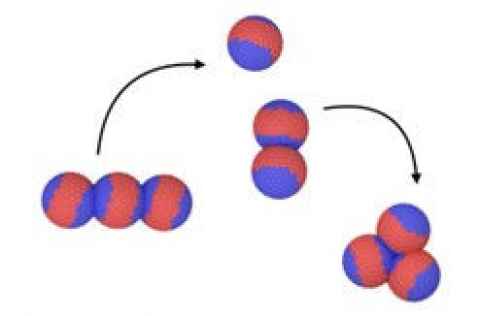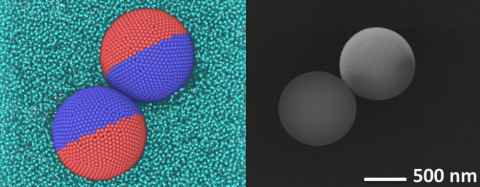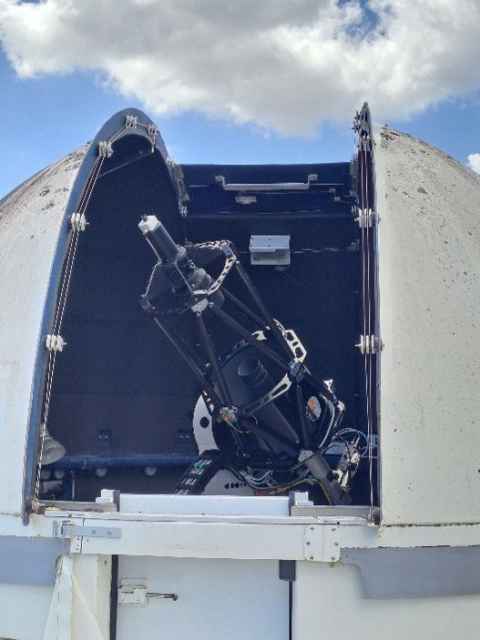Physics
Applications for 2025-2026 open on 1 July 2025
Squishing cells and vesicles
Project code: SCI056
Supervisor(s):
Discipline(s):
Ngā Motu Whakahī
School of Chemistry
School of Physics
Project
This scholarship will be hosted by Ngā Motu Whakahī and is specifically targeted toward students who whakapapa Māori or are of Pacific heritage.
A funded project is available to study soft microparticles (e.g. cells) being squeezed within a constriction (e.g. a pipette tip). This work is part of a project to develop new methods for easily analysing the mechanical properties of soft particles.
The role
The project may be experimental or computational, depending on the student’s interests and skills.
For example, an experimental project could work on collecting and analysing data for a particular set of soft particles. A theory / computational project could work on models that are used to find mechanical properties based on experimental data.
Lab website: https://fluidics.physics.auckland.ac.nz/
Spectroscopy for conservation of museum items
Project code: SCI060
Supervisor(s):
Cushla McGoverin, Department of Physics
Carlie Watt
Discipline(s):
Ngā Motu Whakahī
Physics
Project
This is a Ngā Motu Whakahī scholarship specifically targeted toward students who whakapapa Māori or are of Pacific heritage.
In this project the student will learn to collect infrared and Raman spectra from a variety of plastic-based samples and analyse this data to determine if degradation of the plastics has occurred. The aim of these studies is to understand degradation of cultural items of significance.
Ideal student
This project would suit students in physics, chemistry, computer science or intending to do postgraduate study in museums and cultural heritage.
Connecting Community and Retention in STEM through the Tuākana Program
Project code: SCI063
Supervisor(s):
Discipline(s):
Ngā Motu Whakahī
Physics
Statistics
Project
This is a Ngā Motu Whakahī scholarship specifically targeted toward students who whakapapa Māori or are of Pacific heritage.
The role
We will develop a survey for participants in the Tuākana program in Physics and Stats (possibly also Maths) at the University of Auckland Waipapa Taumata Rau. The survey, consisting of mostly open-ended items, will help to understand previous research that suggested a connection between retention in physics and participation in Tuākana. The survey will invite descriptions of whakawhanaungatanga as it relates to persisting through a STEM degree. The survey will be sent to Tuākana participants after this summer project.
Simulating the self-assembly of Janus particles using molecular dynamics
Project code: SCI065
Supervisor(s):
Dr Kannan Ridings (Rongowhakaata)
Discipline(s):
Ngā Motu Whakahī
Physics

Project
This is a Ngā Motu Whakahī scholarship specifically targeted toward students who whakapapa Māori or are of Pacific heritage.
Janus particles are micro/nanoparticles with two specific chemistries at their surfaces, having applications in drug-delivery systems or catalysis. When many Janus particles are put in the same environment (e.g. a fluid) they exhibit self-assembly characteristics, forming interesting structures.
The role
This project will involve using molecular dynamics simulations to explore the self-assembly behaviour of three or more Janus particles interacting together in a fluid.
Ideal student
This project would be suited to a student interested in computational/theoretical physics or chemistry at the postgraduate level.
Exploring nanofilament growth and dissolution for atomic switches using molecular dynamics simulation and machine learning methods
Project code: SCI066
Supervisor(s):
Dr Kannan Ridings (Rongowhakaata)
Discipline(s):
Ngā Motu Whakahī
Physics

Project
This is a Ngā Motu Whakahī scholarship specifically targeted toward students who whakapapa Māori or are of Pacific heritage.
Resistive Random-Access Memory (RRAM) devices are promising alternatives which switch between states comparable to traditional memory while using significantly less energy and retain information when powered off. These atomic switches aim to be a new paradigm in computing technology in the 21st century.
A single unit in one of these devices is a simple atomic switch, where a potential difference is applied between two electrodes, causing positively charged ions to diffuse through an electrolyte layer between the electrodes, and a nanofilament can form.
The role
This project aims to investigate the mechanisms of growth and dissolution in these atomic switches using molecular dynamics simulation and machine learning methods to understand how the electrolyte environment influences this process.
Drop Impacts and Capillarity
Project code: SCI072
Supervisor(s):
Discipline(s):
Physics

Project
Experimental projects are available to study microscale liquid dynamics using high-speed photography (producing cool slow-motion videos). We are particularly interested in drop impact experiments, in which drops collide with solid surfaces. Fluids of interest include partially dried dairy products, and ferrofluids which produce ‘spiky’ magnetic instabilities. Surfaces may be patterned in order to control the spreading, splashing and rebounding of the drops. A project could also focus on development of image analysis techniques.
Ideal students
Projects are suitable for students from any quantitative science / engineering background, and can be aligned with industrial (real-world) applications.
Skills gained
Skills will include experimental methods for materials science, and understanding of fluid dynamics.
Lab website: https://fluidics.physics.auckland.ac.nz/
Soft Matter Models (Theory / Computational)
Project code: SCI073
Supervisor(s):
Discipline(s):
Physics

Project
Projects are available to develop and use computational analysis methods and/or theoretical models to study two interesting soft matter systems:
(i) Assemblies of asymmetric Janus spheres, which consist of two hemispheres with distinct properties. Computational methods will be used to study the how Janus microspheres approach each other in microfluidic flows, and their relative orientation within small clusters. Understanding of how these microparticles can be assembled into larger-scale structures can assist with creation of new sustainable materials.
(ii) Soft microparticles (e.g. cells) undergoing deformation within a constriction. This work is relevant to development of new methods for easily analysing the mechanical (or more fully, rheological) properties of such particles.
Ideal student
Computational / numerical projects are especially suitable for students with some relevant experience.
Lab website: https://fluidics.physics.auckland.ac.nz/
Acoustically Levitated Droplets
Project code: SCI074
Supervisor(s):
Discipline(s):
Physics
Project
Project(s) are available to study levitating droplets in the Dynamic Microfluidics Lab. Drying of droplets as they drift through the air is a critical process for some of the most important scientific challenges of our times, including climate science and the spread of infectious diseases.
The role
The student would carry out experiments and/or analysis for droplets held by an acoustic levitator. This instrument can hold a droplet suspended in air while the surrounding atmosphere is controlled, allowing the kinetics of droplet nucleation, growth and drying to be studied.
Lab website: https://fluidics.physics.auckland.ac.nz/
How do crustaceans hear?
Project code: SCI075
Supervisor(s):
Discipline(s):
Physics
Project
It is well-established that crustaceans are using sound for interspecies communication. However, the mechanism for sound detection is still poorly understood.
The role
To fill this research gap, we employ optical coherence tomography-based vibrometry to measure the mechanical response of different organs to acoustic stimuli. We seek help conducting large-scale experiments on snapping shrimp and Aotearoa paddle crabs.
Skills gained
During the project, you will gain insights into optical coherence tomography and how to conduct experiments to produce statistically significant results.
Holographic imaging with incoherent light
Project code: SCI076
Supervisor(s):
Discipline(s):
Physics
Project
Traditional holography is well known for its ability to capture three-dimensional object information in a single image but is limited by the requirement for light with a high degree of spatiotemporal coherence.
The role
To overcome this limitation, we are implementing a novel incoherent holography scheme. To help us bring the idea to reality, we seek help in implementing, calibrating, and characterizing a proof of concept setup.
Skills gained
In the process, you will gain hands-on experience in imaging and polarization optics and image processing for holography.
Imaging techniques for pests’ detection and elimination in beehives
Project code: SCI077
Supervisor(s):
Discipline(s):
Physics
Project
The project aim is to perform field trials to validate a parasite imaging and elimination system in beehives.
Required skills
Good teamwork is required, as well as some experience with lasers and optical components, imaging systems, data acquisition and processing. Some knowledge of animal biology is preferred.
The candidate should be willing to travel to Hamilton to perform such trials.
Pollen characterization by spectroscopic techniques
Project code: SCI078
Supervisor(s):
Discipline(s):
Physics
Project
The project aim is to characterize pollen carried by honeybees using spectroscopic techniques such as FTIR, Raman, etc.
Skills
Good teamwork is required, and some basic knowledge of spectroscopy is preferable.
Dial your number: generate the number of photons you want
Project code: SCI079
Supervisor(s):
Discipline(s):
Physics
Project
This project involves using laser cooling and trapping to trap a single atom on an optical nanofibre: a fibre that has been drawn out to a diameter of 400 nm. The nanofibre is part of a fibre resonator.
The role
You will work with the team to isolate a single photon and cause it to stimulate emission into the nanofibre and then detect these photons. Regard this project as a great opportunity to learn about laser and general laboratory skills as well as quantum physics.
Two-dimensional quantum gases
Project code: SCI080
Supervisor(s):
Discipline(s):
Physics
Project
In this project you will work with the team to create quantised vortices in a two-dimensional “quantum fluid”. We trap ultracold atoms in a sheet of laser light, from where these atoms can’t escape. The atoms are so cold that their wave functions overlap.
The role
You will work on then generating vortices by “stirring” this quantum fluid with a spoon made of laser light. Regard this project as a great opportunity to learn about laser and general laboratory skills as well as quantum physics.
Project
This is a project in theoretical quantum optics, with particular emphasis on cavity quantum electrodynamics (cavity QED) – the interaction of atoms with quantised light fields inside optical resonators. Our specific interest is in the controlled preparation of uniquely quantum-mechanical states of both atoms and light fields. Such states are of interest from a fundamental point of view as well as being of basic importance in the topical fields of quantum information processing (e.g., quantum communication and computing) and many-body quantum physics.
The role
The project will involve a combination of analytical and numerical calculations using simple models and established techniques of theoretical quantum optics.
Image Recognition of Proteins in Microgravity
Project code: SCI082
Supervisor(s):
Prof. Cather Simpson
Discipline(s):
Physics
Project
The role
The student will combine photonics with machine-learning approaches to characterize protein structure formation. It is an interdisciplinary and cross-institutional summer research project, which is interlinked with the biotechnology and aerospace research sector.
Skills gained
The student will develop skills in the area of (non)-linear optics, microscopy and/or spectroscopy, and will work in our team based at the Photon Factory at UoA.
Ideal student
Especially helpful is having a background in physics, computer science, machine-learning and/or software engineering.
Robotic Lightweight Mirror Protector for Taiaho Observatory Optical Ground Station
Project code: SCI162
Supervisor(s):
Discipline(s):
Physics

Project
Within Taiaho Observatory is a 304mm diameter Ritchey-Chretian telescope used for laser communications. This telescope is constructed with exposed trusses and mirrors, which must be protected from dust/dew, and is intended to be remotely operable.
The role
1. Design a shutter, aperture, or iris that can be opened and closed remotely to be installed on the telescope.
2. Liaise with the current FSOC team to integrate the shutter robotics into the existing software/hardware.
3. Manufacture and install these systems.
Automated Assessment of Air Traffic around Taiaho Observatory Optical Ground Station
Project code: SCI163
Supervisor(s):
Discipline(s):
Physics

Project
Laser-satellite communications involve pointing high-power lasers through the atmosphere. To do this safely requires detailed knowledge of air traffic around the ground station. To that end, we have acquired an Automatic Dependent Surveillance–Broadcast (ADS-B) receiver.
The role
1. Program the receiver to continuously log data and back up to a remote server.
2. Install these systems at Taiaho Observatory.
3. Analyse the data to identify flights that fall within the Extended Nominal Ocular Hazard Distance of the observatory.
Automated Rain Sensing Failsafe for Taiaho Observatory Optical Ground Station
Project code: SCI164
Supervisor(s):
Discipline(s):
Physics

Project
Taiaho Observatory is New Zealand’s first Optical Ground Station for laser satellite communications. To increase the autonomy of the station, it requires robotic failsafes to close the dome shutter in the event of unexpected rain.
The role
1. Design this failsafe using a Hydreon RG-11 Solid State Rain Gauge, microcontroller, and battery.
2. Liaise with the current FSOC team to integrate the robotics into the existing software/hardware.
3. Manufacture and install these systems.